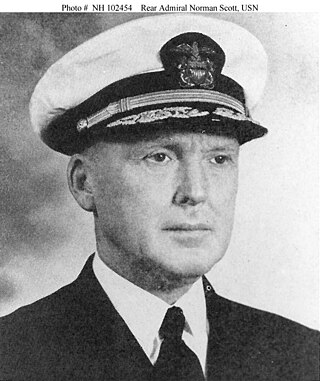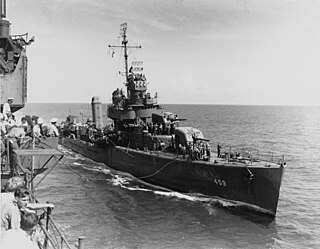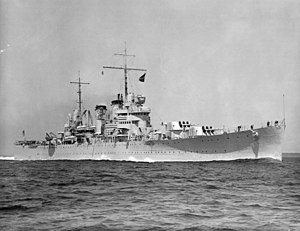
USS Quincy (CL/CA-39) was a United States Navy New Orleans-class cruiser, sunk at the Battle of Savo Island in 1942.

The naval Battle of the Eastern Solomons took place on 24–25 August 1942 and was the third carrier battle of the Pacific campaign of World War II and the second major engagement fought between the United States Navy and the Imperial Japanese Navy (IJN) during the Guadalcanal campaign. As at the Battle of the Coral Sea and the Battle of Midway, the ships of the two adversaries were never within sight of each other. Instead, all attacks were carried out by carrier-based or land-based aircraft.

USS Juneau (CL-52) was a United States Navy Atlanta-class light cruiser torpedoed and sunk at the Naval Battle of Guadalcanal on 13 November 1942. In total, 687 officers and sailors, including the five Sullivan brothers, were killed in action as a result of her sinking. Only 10 survivors were rescued after eight days in the water. To honor the five Sullivan brothers and Juneau, the U.S. Navy has since commissioned two ships named USS The Sullivans and two ships named USS Juneau. On 17 March 2018, Paul Allen's research crew on board RV Petrel located the wreck of Juneau at a depth of about 4,200 m (13,800 ft) off the Solomon Islands.

USS Chicago (CL/CA-29) was a Northampton-class cruiser of the United States Navy that served in the Pacific Theater in the early years of World War II. She was the second US Navy ship to be named after the city of Chicago. After surviving a midget submarine attack at Sydney Harbour and serving in battle at the Coral Sea and Savo Island in 1942, she was sunk by Japanese aerial torpedoes in the Battle of Rennell Island, in the Solomon Islands, on 30 January 1943.

USS Honolulu (CL-48) of the United States Navy was a Brooklyn-class light cruiser active in the Pacific War. Honolulu was launched in 1937 and commissioned in 1938. The ship served in the Battle of Tassafaronga, the Battle of Kula Gulf, the Battle of Kolombangara and the Battle of Peleliu. She was taken out of action by serious torpedo damage just before the Battle of Leyte Gulf. She was repaired, but not in time to rejoin the war. She was decommissioned in 1947 and was held in reserve until she was scrapped in 1959.

USS Minneapolis (CL/CA-36) was a New Orleans-class cruiser built for the United States Navy before the outbreak of World War II, the second ship named for Minneapolis, Minnesota. She served in the Pacific Theater during World War II.

USS Nashville (CL-43) was a Brooklyn-class cruiser. She was laid down on 24 January 1935 by New York Shipbuilding Corporation, Camden, New Jersey. She was launched on 2 October 1937, sponsored by Misses Ann and Mildred Stahlman and commissioned on 6 June 1938.

Mahan-class destroyers of the United States Navy were a series of 18 destroyers of which the first 16 were laid down in 1934. The last two of the 18, Dunlap and Fanning, are sometimes considered a separate ship class. All 18 were commissioned in 1936 and 1937. Mahan was the lead ship, named for Rear Admiral Alfred Thayer Mahan, an influential historian and theorist on sea power.

HMAS Hobart was a modified Leander-class light cruiser which served in the Royal Australian Navy (RAN) during World War II. Originally constructed for the Royal Navy as HMS Apollo, the ship entered service in 1936, and was sold to Australia two years later. During the war, Hobart was involved in the evacuation of British Somaliland in 1940, fought at the Battle of the Coral Sea and supported the amphibious landings at Guadalcanal and Tulagi in 1942. She was torpedoed by a Japanese submarine in 1943, then returned to service in 1945 and supported the landings at Tarakan, Wewak, Brunei, and Balikpapan. Hobart was placed in reserve in 1947, but plans to modernise her and return her to service as an aircraft carrier escort, training ship, or guided missile ship were not followed through. The cruiser was sold for scrapping in 1962.

The Battle of Cape Esperance, also known as the Second Battle of Savo Island and in Japanese sources as the Sea Battle of Savo Island (サボ島沖海戦), took place on 11–12 October 1942, in the Pacific campaign of World War II between the Imperial Japanese Navy and United States Navy. The naval battle was the second of four major surface engagements during the Guadalcanal campaign and took place at the entrance to the strait between Savo Island and Guadalcanal in the Solomon Islands. Cape Esperance (9°15′S159°42′E) is the northernmost point on Guadalcanal, and the battle took its name from this point.

Norman (Nicholas) Scott was a rear admiral in the United States Navy. He was killed along with many of his staff when the ship he was on – the light cruiser USS Atlanta – was hit by gunfire from the heavy cruiser USS San Francisco during the nighttime fighting in the Naval Battle of Guadalcanal. He was the second of five US Navy admirals killed in battle during WWII, including: Isaac C. Kidd ; Daniel J. Callaghan ; Henry M. Mullinnix ; and Theodore E. Chandler.

USS Bulmer (DD-222/AG-86) was a Clemson-class destroyer in the United States Navy during World War II. It was the last warship of the Asiatic Fleet in USN commission.

USS McCalla (DD-488), a Gleaves-class destroyer, was the second ship of the United States Navy to be named for Bowman H. McCalla, who served during the Spanish–American War and would eventually attain the rank of rear admiral.

USS Trever (DD-339/DMS-16/AG-110) was a Clemson-class destroyer of the United States Navy in commission from 1922 to 1923 and from 1930 to 1945. Converted to a destroyer minesweeper in 1940, she served in the Pacific throughout World War II, including during the Japanese attack on Pearl Harbor, the Guadalcanal campaign, and the New Georgia campaign.

USS Laffey (DD-459) was a Benson-class destroyer of the United States Navy during World War II. She was the first destroyer named for Seaman Bartlett Laffey. She was lost in action on 13 November 1942.

Nagara (長良) was the lead ship of her class of light cruiser in the Imperial Japanese Navy. She was named after the Nagara River in the Chūbu region of Japan.

Kinugasa (衣笠) was the second vessel in the two-vessel Aoba class of heavy cruisers in the Imperial Japanese Navy. The ship was named after Mount Kinugasa, located in Yokosuka, Kanagawa, Japan.

Sendai was a Sendai-class light cruiser in the Imperial Japanese Navy. She was named after the Sendai River in southern Kyūshū. Sendai was the lead ship of the three vessels completed in her class of light cruisers, and like other vessels of her class, she was intended for use as the flagship of a destroyer flotilla.

Hatsuyuki was the third of twenty-four Fubuki-class destroyers built for the Imperial Japanese Navy following World War I. When introduced into service, these ships were the most powerful destroyers in the world. They served as first-line destroyers through the 1930s, and remained formidable weapons systems well into the Pacific War.

Jintsū (神通) was the second vessel completed in the three-ship Sendai-class light cruiser in the Imperial Japanese Navy (IJN), named after the Jinzū River in the Gifu and Toyama prefectures of central Japan. She was active in World War II in various campaigns including the Japanese invasion of the Philippines, the Battle of the Java Sea, and Battle of Midway. On 13 July 1943 in the Battle of Kolombangara, she was discovered during a night attack by American ships and sunk in combat.






















